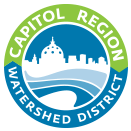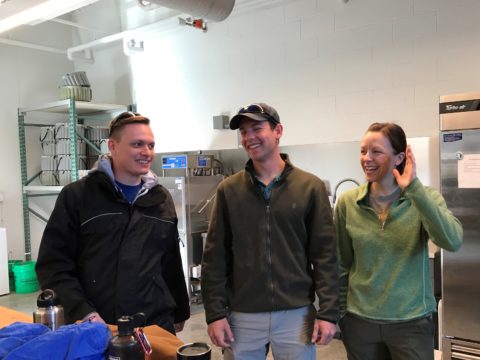
It’s chilly for May, the morning is overcast, and rain is predicted for the next day. We gather supplies in the shop and pack the truck with sampling tools and supplies. Today we’re collecting base samples of water flow in the storm sewers before the next rainfall. Our group will check the sensor stations around CRWD and prepare the sensors to record the next round of stormwater data. I join Sarah to visit three stations while Joe and Mark head out to the other stations. Sarah, Joe and Mark are Water Resource Technicians, part of a team of six people in CRWD’s Monitoring, Research & Maintenance Division. They are responsible for monitoring water quantity and quality, gathering data from the monitoring, and using the data for research to understand how well the stormwater improvements are working and to understand long-term changes in water quantity and quality.
STORM SEWER SYSTEM
Beneath our feet there are over 500 miles of storm sewers in Capitol Region Watershed District (CRWD). Whenever it rains or the snow melts, water flows over hard surfaces, such as rooftops, sidewalks and parking lots, and into a storm sewer system. Storm sewers consist of a series of pipes that move water quickly from city streets to lakes and the Mississippi River. The water is simply transported and does not receive any treatment. CRWD keeps a close watch on the water within the storm sewers with various monitoring stations, including the six stations with sensors that continuously monitor data year-round. These stations record water levels, velocity, discharge, water quality (nutrients, solids, metals, and bacteria) and pollutants. CRWD uses the sensor stations to collect storm event (rainfall) and normal flow (dry weather) water samples. The “normal flow” base composite samples* (see definition below) are collected monthly to provide a standard measure of the long-term water quantity and quality within CRWD. The monitoring team has a full schedule of sampling water and recording data. When they asked for extra help with a recent sampling trip I was excited to join for a chance to see what they do up close.
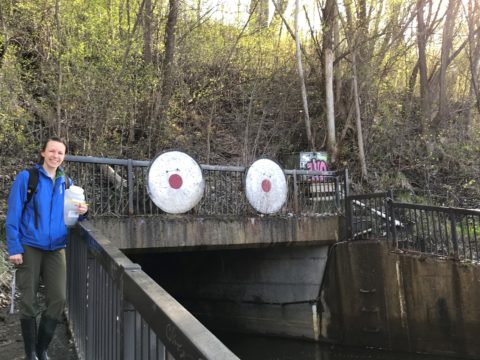
SAINT ANTHONY PARK
Our first stop is the St. Anthony Park station at the western edge of CRWD. We’re welcomed by playful plywood eyes that were mysteriously added to the railing above the storm sewer outlet a few years ago. Sarah tells me there were lightning bolt eyebrows too, but those have since fallen off. Tiny goslings in tow, a family of geese glides to the river as we approach the monitoring station. We use a bucket and a rope to take a water sample from the railing above the outlet. Sarah explains that the sensor hasn’t been connected yet this spring because the water is too high to safely wade into the storm sewer outlet. We drop a bucket into the water below and fill a clean sample jug and an E.Coli bacteria test bag to send to the lab. At each station Sarah connects a laptop to download the recorded data from the sensor.
HIDDEN FALLS
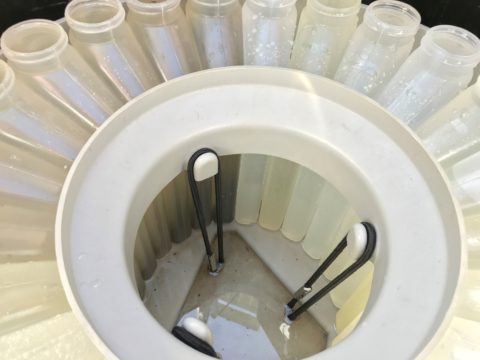
Birds are chirping and sun peeks through the clouds as we walk to the next station at the top of Hidden Falls. The Highland Park monitoring station sits inside the pipe that feeds the water falls of Hidden Falls. We open the sample bottle barrel to find empty bottles, the pump tubing had disconnected. We dump the stormwater that had pooled in the bottom of the barrel and fix the tubing with a zip tie so it can collect the next round of samples. We fill a sample jug and test bag directly from the outlet at the top of Hidden Falls.
EAST KITTSONDALE
Our final water samples of the morning are taken from 20 feet below ground at the East Kittsondale station. Inside the sampling barrel half of the bottles are filled with water from a storm event (rainfall) the week before. This water is much darker** than the base water samples and sediment covers the bottom of the bottles. We cap our base samples that were pumped over the past 24 hours and dump out the older rainwater. To reach the sensor at East Kittsondale one of CRWD’s monitoring staff must use a harness, gas meter and safety measures to climb two stories below the ground into the storm sewer system. Entering the storm sewers can be dangerous. Staff that need to enter the pipes and tunnels complete an annual training and always use safety equipment. Thankfully, the sensor has a pump to collect the water so they don’t have to descend each time they need a sample.
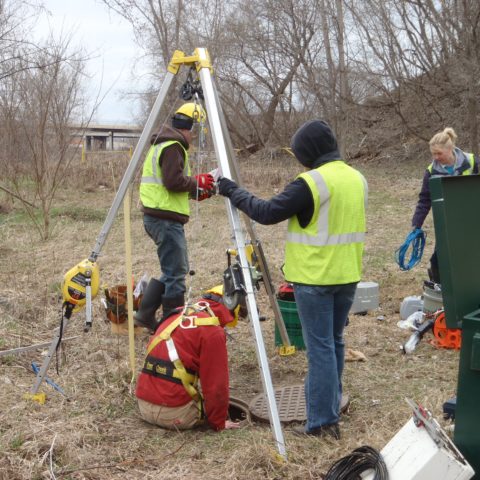
When we get back to the shop Joe and Mark have already returned from their sampling stations. All of the base samples are then mixed together to create a composite sample that is sent to the nearby Metropolitan Council Environmental Services (MCES) Laboratory for testing the water quality and pollutant load, along with the separate E.Coli bacteria levels from each site. The next morning Sarah, Joe and Mark prepare to collect the next round of water samples while the forecasted rain begins to fall.
*Base Composite Samples – Base composite samples mix many 200mL samples collected over a 24 hour period at a monitoring station to create a single 4000mL composite sample for laboratory analysis.
**What’s in the storm sewer rainwater? The first 1 inch of rainfall carries the most sediment, debris, and pollutants from hard surfaces like roads, rooftops and parking lots. It then enters the storm sewer system and makes its way to our lakes and the Mississippi River. Stay tuned for a future post on rain water sampling to learn more.
LINKS
- View the Water Data Reporting Tool
- Check out our Monitoring & Research webpage
- Learn more about CRWD’s Stormwater Data Collection & Analysis
